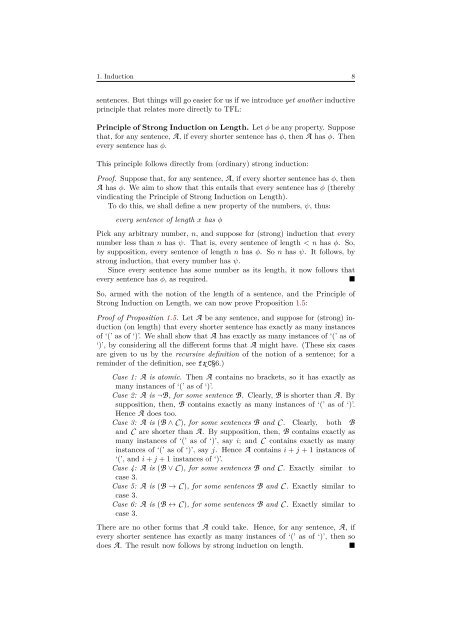Metatheory - University of Cambridge
Metatheory - University of Cambridge
Metatheory - University of Cambridge
Create successful ePaper yourself
Turn your PDF publications into a flip-book with our unique Google optimized e-Paper software.
1. Induction 8<br />
sentences. But things will go easier for us if we introduce yet another inductive<br />
principle that relates more directly to TFL:<br />
Principle <strong>of</strong> Strong Induction on Length. Let ϕ be any property. Suppose<br />
that, for any sentence, A, if every shorter sentence has ϕ, then A has ϕ. Then<br />
every sentence has ϕ.<br />
This principle follows directly from (ordinary) strong induction:<br />
Pro<strong>of</strong>. Suppose that, for any sentence, A, if every shorter sentence has ϕ, then<br />
A has ϕ. We aim to show that this entails that every sentence has ϕ (thereby<br />
vindicating the Principle <strong>of</strong> Strong Induction on Length).<br />
To do this, we shall define a new property <strong>of</strong> the numbers, ψ, thus:<br />
every sentence <strong>of</strong> length x has ϕ<br />
Pick any arbitrary number, n, and suppose for (strong) induction that every<br />
number less than n has ψ. That is, every sentence <strong>of</strong> length < n has ϕ. So,<br />
by supposition, every sentence <strong>of</strong> length n has ϕ. So n has ψ. It follows, by<br />
strong induction, that every number has ψ.<br />
Since every sentence has some number as its length, it now follows that<br />
every sentence has ϕ, as required.<br />
■<br />
So, armed with the notion <strong>of</strong> the length <strong>of</strong> a sentence, and the Principle <strong>of</strong><br />
Strong Induction on Length, we can now prove Proposition 1.5:<br />
Pro<strong>of</strong> <strong>of</strong> Proposition 1.5. Let A be any sentence, and suppose for (strong) induction<br />
(on length) that every shorter sentence has exactly as many instances<br />
<strong>of</strong> ‘(’ as <strong>of</strong> ‘)’. We shall show that A has exactly as many instances <strong>of</strong> ‘(’ as <strong>of</strong><br />
‘)’, by considering all the different forms that A might have. (These six cases<br />
are given to us by the recursive definition <strong>of</strong> the notion <strong>of</strong> a sentence; for a<br />
reminder <strong>of</strong> the definition, see fx C§6.)<br />
Case 1: A is atomic. Then A contains no brackets, so it has exactly as<br />
many instances <strong>of</strong> ‘(’ as <strong>of</strong> ‘)’.<br />
Case 2: A is ¬B, for some sentence B. Clearly, B is shorter than A. By<br />
supposition, then, B contains exactly as many instances <strong>of</strong> ‘(’ as <strong>of</strong> ‘)’.<br />
Hence A does too.<br />
Case 3: A is (B ∧ C ), for some sentences B and C . Clearly, both B<br />
and C are shorter than A. By supposition, then, B contains exactly as<br />
many instances <strong>of</strong> ‘(’ as <strong>of</strong> ‘)’, say i; and C contains exactly as many<br />
instances <strong>of</strong> ‘(’ as <strong>of</strong> ‘)’, say j. Hence A contains i + j + 1 instances <strong>of</strong><br />
‘(’, and i + j + 1 instances <strong>of</strong> ‘)’.<br />
Case 4: A is (B ∨ C ), for some sentences B and C . Exactly similar to<br />
case 3.<br />
Case 5: A is (B → C ), for some sentences B and C . Exactly similar to<br />
case 3.<br />
Case 6: A is (B ↔ C ), for some sentences B and C . Exactly similar to<br />
case 3.<br />
There are no other forms that A could take. Hence, for any sentence, A, if<br />
every shorter sentence has exactly as many instances <strong>of</strong> ‘(’ as <strong>of</strong> ‘)’, then so<br />
does A. The result now follows by strong induction on length.<br />
■
















